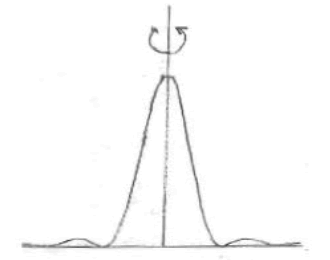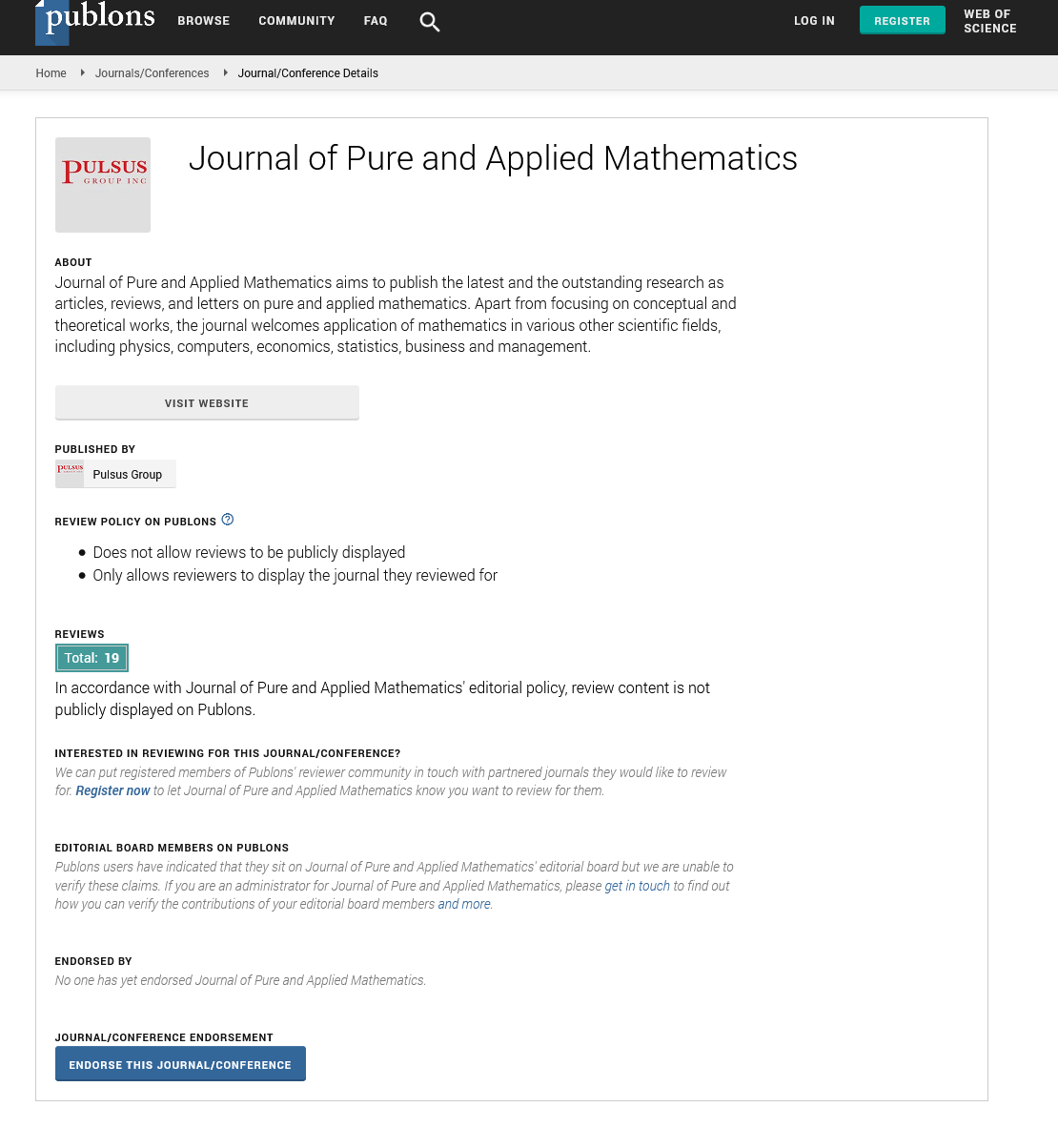A formula for electron mass calculation based on new fundamental concepts
Received: 13-Mar-2023, Manuscript No. puljpam-23-6281; Editor assigned: 14-Mar-2023, Pre QC No. puljpam-23-6281 (PQ); Accepted Date: Mar 30, 2023; Reviewed: 17-Mar-2023 QC No. puljpam-23-6281 (Q); Revised: 18-Mar-2023, Manuscript No. puljpam-23-6281 (R); Published: 31-Mar-2023, DOI: 10.37532/2752-8081.23.7(2).129-133
Citation: Raverdy YC. A formula for electron mass calculation based on new fundamental concepts. J Pure Appl Math. 2023;7(2):129-133.
This open-access article is distributed under the terms of the Creative Commons Attribution Non-Commercial License (CC BY-NC) (http://creativecommons.org/licenses/by-nc/4.0/), which permits reuse, distribution and reproduction of the article, provided that the original work is properly cited and the reuse is restricted to noncommercial purposes. For commercial reuse, contact reprints@pulsus.com
Abstract
We present a novel formula for the mass of the electron as a function of four fundamental constants of electromagnetism and gravitation: the fine structure constant, Planck's constant, the speed of light, and the gravitational constant. We derive the formula in three major steps.
First, we model the electron as a decreasing standing wave, solution of the propagation equation coming from Maxwell's relations. We consider its wave number k0 as a key value of electromagnetism. The internal energy is distributed according to the square of the amplitude of the wave.
Second, we make the hypothesis that the field of the wave has lower and upper bounds. Assuming quantization of kinetic momentum we find that the logarithm of the quotient of these bounds can be assimilated to the inverse of the fine structure constant. Third, we propose that vacuum space is a granular fluid medium. The value k0 is such that it implies opacity of the electron wave to gravitons, which are the elementary dynamic corpuscles of the fluid.
Keywords
Electron mass; Calculation; Fundamental; Novel formula
Introduction
The mass of the electron, which is one of the fundamental constants of physics, is known with high precision by experimental measurement, but the theoretical justification of this mass, as well as of other elementary particles, is still an unsolved problem.
We propose a novel formula for the electron mass in stationary state in a new framework which appeals directly to the ideas which have been at the basis of main theories in force today.
In this context, it is worth recalling the essential contribution of Louis De Broglie, who discovered the wave character of particles and its close relationship with the principles of Special Relativity [1-2]. De Broglie considered a particle as a “small moving clock” along a wave radius and having continually the same phase [3]. We give here, for the first time, a meaning to the expression “small clock”, treating the fundamental nature of the electron as a real physical static wave, solution of Maxwell's equation.
We also recall that the first attempt to explain Newton's force was a Corpuscular theory [1-12].
Our proposal is based on three main axes. First, the fact that the electron can be represented as a decreasing wave, which is a solution of the second order partial differential equation resulting from Maxwell's relations in vacuum.
Second, we bound this wave by two lengths whose quotient logarithm is the fine structure constant. This quotient is obtained by quantization of the angular momentum of the wave function.
Third, the introduction of a corpuscular theory for gravitation furnishes the last element for the establishment of the formula. Respecting the quantization principle we postulate the opacity of the wave with respect to gravitons. This part leads to a novel connection between Electromagnetism and Gravitation.
Presentation of the formula
The formula below gives the value of gravitational inertia which is the mass (me) defining the total static internal energy of the electron (mec2). It presents the remarkable property of combining the four fundamental constants of electromagnetism and gravitation.

where:
h is Planck's constant,
c is the speed of light in vacuum,
G is the gravitational constant,
ω is a dimensionless quantity comparable to the inverse of thefine structure constant (1/α).
We will return to the value of ω with the numerical evaluation of the formula in 6.
The remainder of this publication is devoted to the justification of the formula.
The internal wave of the electron, solution of the general wave equation
We started from the idea that the second order partial derivative propagation equations resulting from Maxwell's relations are basic for the description of static and massive particles, as well as of dynamic particles without mass.
Indeed, this wave equation:

leads to the Klein-Gordon equation for guided propagation, the nonrelativistic version of which is Schrödinger's equation (11). Another very important tensorial variant is Dirac's equation (4) and (10). These equations proceed from a dynamic point of view and describe all properties of the particle.
We have considered stationary and monochromatic radial (spherical symmetry) solutions of equation (2) which can then be written:

where the first two terms express the Laplacian in polar coordinates depending only on r, and the third term expresses that the phase is monochromatic.
The main solution in the form  , setting
k = k0 (cf.
section 5) is:
, setting
k = k0 (cf.
section 5) is:

This solution presents the essential advantage of being convergent for r → 0 . It seems natural to attribute this solution to the electron because of its variation with 1/r, reminiscent of the electrostatic potential.
We also make the assumption that the wave field is bounded by lower and upper values, respectively l0 and R, these values will be interpreted [9].
Using these elements, we write a first formula for the internal energy with values proportional to the square of the amplitude of the wave, depending on r only.

 is the coefficient of elementary electrostatic field energy, so
is the coefficient of elementary electrostatic field energy, so

where q is the elementary charge and ε the dielectric constant in vacuum (with an approximation discussed).
Given that the extremal values l0 and R are, as we will see, respectively very small and very large, the value of the integral (3) can be calculated by integration from 0 to ∞ .

Internal angular momentum
As we said, it is considered that the internal energy of the electron is distributed in space according to the value of the square of decreasing spherical wave amplitude expressed by the function sin2(kr)/r2
A quick calculation shows that approximately 85% of this energy belongs to the central pulsation. To go further it is necessary to dimension the structure, and we have to consider the existence of the internal angular momentum. The particle is modeled as a complex vortex inside the uid medium constituting the vacuum [6-7]. One component of the angular momentum then is the rotational vector, product of the impulse momentum vector and the radius vector, and whose modulus m (m=mecr) can be related to the internal orbital angular momentum (Figure 1).
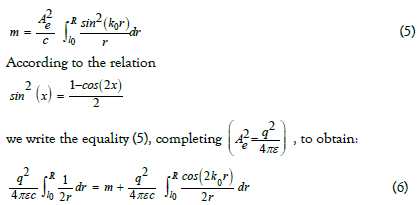
We compare this equality to the quantum composition of the
Internal kinetic momentum, which is the sum of an Electro-magnetic
(m) and an Only-magnetic (s), similarly to some solutions of Dirac
equation, whose values are intrinsic to the particle.
We assume that the terms of this equality are the projections of the
modules of the vectors expressing the orbital and magnetic moments.
So the first member can be assimilated to the quantum value of the
total momentum (internal angular momentum) whose value is  then solving the integral allows us to write:
then solving the integral allows us to write:

This equality implies the equivalence of ln  with inverse of
the fine structure constant
with inverse of
the fine structure constant 
As an appendix we present the result of an electromagnetic energy model, which confirms this equivalence, it is also a way to emphasize the importance of this result.

We will not discuss here the calculation of the integrals relative to m and s, which would lead beyond the scope of our presentation which is the simple justification of the formula for the mass of the electron. This result justifies the application of the limits R and l0 , calculated in the next chapter, to the wave of the electron, in virtue of the equivalence of ln (R/l0) to the inverse of the fine structure constant, in the approximation discussed in chapter 6.
The wave number k0
We formulate the hypothesis that the value of k0 corresponds to a common vibration frequency for all elementary particles with spin 1/2, it must be considered as a universal constant. For a massive boson, the wave number is k = 2k0 .
To determine its value, we consider that the empty space is constituted by a quantum character uid which underlies our corpuscular interpretation of gravitation [5].
In this medium, each elementary particle is reacting with the uid medium, the interaction results in the exchange of an elementary action h for each vibration period of the wave particle.
This exchange corresponds to the emission of a graviton which is a wave of minimal impulse (μ0c) corresponding to the propagation of an elementary constituent deficit inside the quantum fluid medium. In this context, 2k0 is defined as the wave number of a photon with minimal electromagnetic energy, the wave section of which is opaque to gravitons.
Gravitons are the particles producing the gravitational force by exchange of an elementary action h with particles of matter.
This principle of minimality then applies to all elementary particles which thus see their vibration frequency fixed at k0c for fermions, and 2k0c for massive bosons.
The electromagnetic wave section corresponds to half the surface of a wavelength which figures the vortex and where the total energy of the wave is distributed.
Why such a definition? The idea is to establish a criterion for applying Newton's laws to elementary particles based on particle wave opacity (at minimum) to gravitons, which confers a quantum character to gravitation, because for this case a single graviton must react with the entire electron within its cross section.
For the calculation of k0 consider first the value l0 introduced in chapter3.
We suggest that l0 , which is the lower bound of the electron wave field, is also the shortest elementary interval, that is to say the length of the building block for all physical beings, including the associated graviton.
In our corpuscular theory of Gravitation, a mass M is both emitting and absorbing gravitons, Newton's force is due to the capture of graviton impulse by the receiving mass.
The calculation of l0 is carried out by identification of this strength with the gravity pressure Pg resulting from a mass M exerted on a mass M ' .
We consider that the mass M emits N gravitons per second through an area of 4πr2 , N is the quantum frequency Mc2 / h , which amounts to consider the additivity of the frequencies for each particle constituting the mass M .
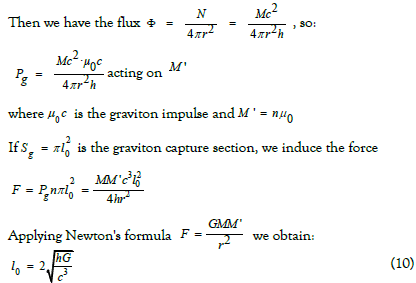
This length is close to the Planck length  it is a
cornerstone of our corpuscular theory which interprets this
quantity as the dimension of the graviton.
it is a
cornerstone of our corpuscular theory which interprets this
quantity as the dimension of the graviton.
It remains to write that the k vortex-wave surface is opaque to
gravitons whose cross section is 
The k wave energy is uniformly distributed over the surface Sk which
corresponds to the wave vortex section with diameter λ / 2 .So we
have
Sk = πλ2/16
in correspondence of the section
 of
gravitons. We can then write the vortex-wave opacity criterion
of
gravitons. We can then write the vortex-wave opacity criterion

Let us now consider the quantity R, the maximum range of the field of the wave. We formulate the hypothesis that this length is also the radius of the material universe [9], it is, moreover, the range of the electromagnetic field and also the distance corresponding to the elementary action h of a graviton, whose momentum is u0c, we then have:


It suffices to copy this value of k0 into relation (9) expressing the value of l0 given by relation (10) to obtain the formula giving the mass of the electron.
One can easily compute the numerical values of the constants determined by the formulas (10), (8), (13), (12) (setting. ω = 137.0036 see next paragraph):
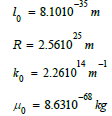
Numerical evaluation of the formula
Using formula (1) one can easily calculate the numerical value of the mass of the electron. The calculation with the following values (CODATA 2018 values):
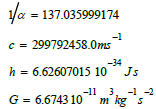
produces the result me=9.009374 10-31 kg, to be compared with the known value 9.1093837015(28) 10-31 kg of the mass of the electron. The relative discrepancy is about 1%.
From this comparison, we draw a double conclusion: on the one hand, given the quality of the result, the formula appears valid, but, on the other hand, there is a difference that requires an explanation. We first note that the calculation is extremely sensitive to the value of : it suffices to choose a value of ω = 137.0036 i.e .decreasing by a factor of 2/10000 to obtain the result me=9.1094 10-31 kg.
We propose the following explanation: Vacuum is a dielectric
medium, and α is depending on the dielectric constant
 but this vacuum is not an entirely
homogeneous medium since it contains at least the electromagnetic
radiations in addition to the basic fluid medium. The energy density
of these radiations remains much lower than that of the total vacuum
energy evaluated by General Relativity.
but this vacuum is not an entirely
homogeneous medium since it contains at least the electromagnetic
radiations in addition to the basic fluid medium. The energy density
of these radiations remains much lower than that of the total vacuum
energy evaluated by General Relativity.
The analysis of Planck satellite images makes it possible to estimate the proportion of radiations with respect to the total energy of the vacuum.
This proportion is approximately 1=10000, which is about half of the relative difference between 1 / α and ω.
Thus our formula, which uses the quantity could serve as a basis for determining the radiation part of vacuum energy. Inversely, the knowledge of total radiation energy would give more precision to the numerical evaluation of the formula.
Conclusion
The formula we arrived at clearly is valid, and we think that it can serve as a springboard for the calculation of other parameters of the standard model. Should we transform our vision of corpuscles, fields and gravity? The concrete image and simple interpretation of the electron we described are maybe part of the answer.
It seems to us that deepening the elements at the base of this article, one can also establish criteria about the nature and the very existence of elementary particles and mass energy identification with that of its wave.
It would be interesting to apply this method to link the mass of the diversity of particles to the various solutions of wave equations (as in (2)), with a quantized angular momentum of multiples of h / 2 . Our result obtained for the electron must nevertheless be integrated with the dynamics of the particle, subject of multiple studies.
To go further, we believe that a gravitational theory compatible with quantum physics must give a conceptual interpretation to the spacetime of Relativity.
The idea of a granular fluid, associated with a corpuscular point of view for gravitation should be a promising approach.
In our view, this paper expresses an important result based on simple physical concepts developed from de Broglie's ideas: it renders precise the profound wave nature of the electron, as well as of other fundamental particles, and proposes a concrete description of vacuum space supporting the space-time used in Relativity.
Appendix: The elementary electromagnetic wave as a resonant circuit
The elementary electromagnetic wave is assimilated to a resonant circuit, this is a model borrowed from macroscopic physics, which does not claim to give a description of the electromagnetic wave, and still less the wave of the electron; its interest is to clarify the hypothesis of the limitation of the electric field limitation with lower and upper values.
We have assumed that these limits are applicable to the wave of the electron.
If L and C are respectively the inductance and the capacitance of a
cylindrical geometry circuit of length l, the resonance frequency is 
We take this frequency for the frequency of a electromagnetic wave to obtain v = c / λ with λ = 2πl
The energy of this wave can be identified with the energy of the circuit:

where q is the elementary charge, ε , l0 and R, respectively, the minimum and maximum radii of the capacitor, which we consider as lower and upper range of the electrostatic field.
Setting the oscillation frequency of the circuit equal to the quantum frequency we obtain

This double equality allows us to introduce by writing:

Which shows 1 / ω to be the fine structure constant if ε = ε0 and thus corroborates the result obtained by the quantization of the angular momentum in chapter 4.
Acknowledgement
I thank Mr. Augustin Lux for his support and his invaluable help.
References
- Broglie Ld. Matière et lumière. Albin Michel. 1937.
- Broglie Ld. Recherche sur la théorie des Quantas. Masson. 1963.
- Broglie Ld , Andrade JL. La réinterprétation de la Mécanique ondulatoire. J Phys Radium. 1971.
- Paul D. The Principles of Quantum Mechanics. Oxf Univ Press. 1930.
- Doligez M, Doligez G. Gravitation: contribution à la théorie corpusculaire de la gravitation. Libr Sci que tech.1965.
- Marco F. Gravity as a uid dynamic phenomenon in a super-uid quantum space. Minist Istr. 2017.
- Justin K. Dark matter super uidity. 2016.
- Georges LL. Encyclopédie de Diderot and D'Alembert. Gravité. 1761.
- Laurent N. La Relativité dans tous ses états : du mouvements aux changements d'échelle. Hachette. 1998.
- Salmon J, Gervat A. Mécanique quantique: Théorie des perturbations, mécanique quantique relativiste. Masson Cie. 1967.
- Michel S. Vibrations, propagation, di usion. Dunod. 1970.
- Sturm S, Köhler F, Zatorski J et al. High-precision measurement of the atomic mass of the electron. Nature. 2014;506:467-70.




